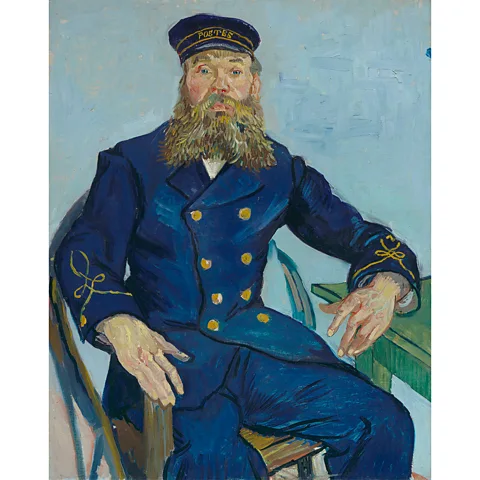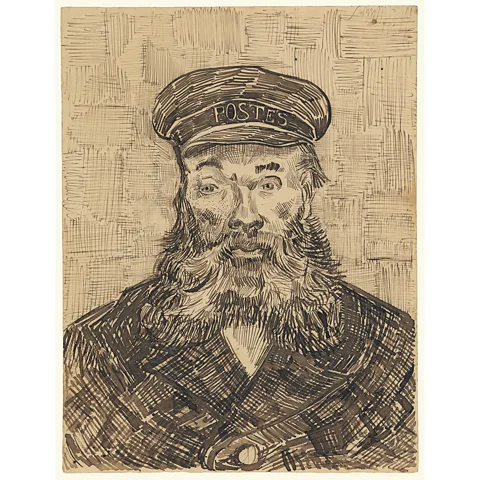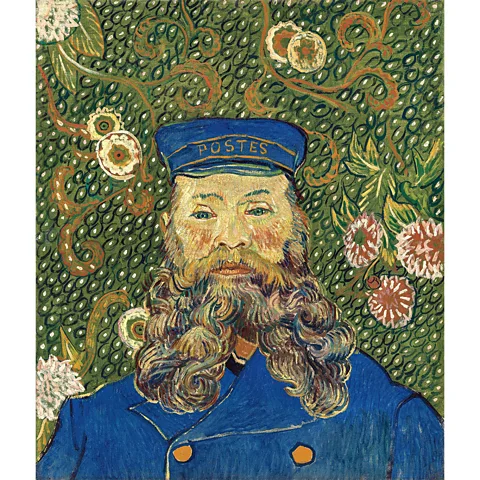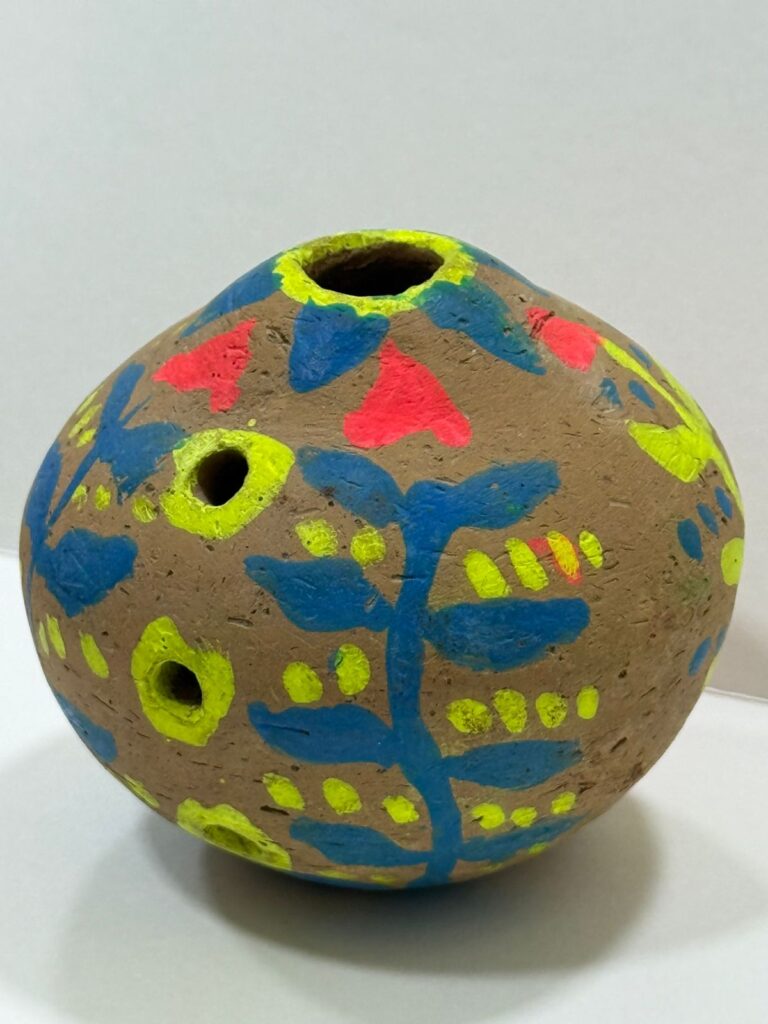Art & Culture
‘A very deep bond of friendship’: The surprising story of Van Gogh’s guardian angel

At the toughest, most turbulent time of his life, the Post-Impressionist painter was supported by an unlikely soulmate, Joseph Roulin, a postman in Arles. A new exhibition explores this close friendship, and how it benefited art history.
On 23 December, 1888, the day that Vincent van Gogh mutilated his ear and presented the severed portion to a sex worker, he was tended to by an unlikely soulmate: the postman Joseph Roulin.
A rare figure of stability during Van Gogh’s mentally turbulent two years in Arles, in the South of France, Roulin ensured that he received care in a psychiatric hospital, and visited him while he was there, writing to the artist’s brother Theo to update him on his condition. He paid Van Gogh’s rent while he was being cared for, and spent the entire day with him when he was discharged two weeks later. “Roulin… has a silent gravity and a tenderness for me as an old soldier might have for a young one,” Van Gogh wrote to Theo the following April, describing Roulin as “such a good soul and so wise and so full of feeling”.
Paying homage to this touching relationship is the exhibition Van Gogh: The Roulin Family Portraits, opening at the MFA Boston, USA, on 30 March, before moving on to its co-organiser, the Van Gogh Museum, Amsterdam, in October. This is the first exhibition devoted to portraits of all five members of the Roulin family. It features more than 20 paintings by Van Gogh, alongside works by important influences on the Dutch artist, including 17th-Century Dutch masters Rembrandt and Frans Hals, and the French artist Paul Gauguin, who lived for two months with Van Gogh in Arles.
Roulin wasn’t just a model for Van Gogh – this was someone with whom he developed a very deep bond of friendship – Katie Hanson
“So much of what I was hoping for with this exhibition is a human story,” co-curator Katie Hanson (MFA Boston) tells the BBC. “The exhibition really highlights that Roulin isn’t just a model for him – this was someone with whom he developed a very deep bond of friendship.” Van Gogh’s tumultuous relationship with Gauguin, and the fallout between them that most likely precipitated the ear incident, has tended to overshadow his narrative, but Roulin offered something more constant and uncomplicated. We see this in the portraits – the open honesty with which he returns Van Gogh’s stare, and the mutual respect and affection that radiate from the canvas.
A new life in Arles
Van Gogh moved from Paris to Arles in February 1888, believing the brighter light and intense colours would better his art, and that southerners were “more artistic” in appearance, and ideal subjects to paint. Hanson emphasises Van Gogh’s “openness to possibility” at this time, and his feeling, still relatable today, of being a new face in town. “We don’t have to hit on our life’s work on our first try; we might also be seeking and searching for our next direction, our next place,” she says. And it’s in this spirit that Van Gogh, a newcomer with “a big heart“, welcomed new connections.

Before moving into the yellow house next door, now known so well inside and out, Van Gogh rented a room above the Café de la Gare. The bar was frequented by Joseph Roulin, who lived on the same street and worked at the nearby railway station supervising the loading and unloading of post. Feeling that his strength lay in portrait painting, but struggling to find people to pose for him, Van Gogh was delighted when the characterful postman, who drank a sizeable portion of his earnings at the café, agreed to pose for him, asking only to be paid in food and drink.
ADVERTISING
Between August 1888 and April 1889, Van Gogh made six portraits of Roulin, symbols of companionship and hope that contrast with the motifs of loneliness, despair and impending doom seen in some of his other works. In each, Roulin is dressed in his blue postal worker’s uniform, embellished with gold buttons and braid, the word “postes” proudly displayed on his cap. Roulin’s stubby nose and ruddy complexion, flushed with years of drinking, made him a fascinating muse for the painter, who described him as “a more interesting man than many people”.

Roulin was just 12 years older than Van Gogh, but he became a guiding light and father figure to the lonely painter – on account of Roulin’s generous beard and apparent wisdom, Van Gogh nicknamed him Socrates. Born into a wealthy family, Van Gogh belonged to a very different social class from Roulin, but was taken with his “strong peasant nature” and forbearance when times were hard. Roulin was a proud and garrulous republican, and when Van Gogh saw him singing La Marseillaise, he noticed how painterly he was, “like something out of Delacroix, out of Daumier”. He saw in him the spirit of the working man, describing his voice as possessing “a distant echo of the clarion of revolutionary France”.
The friendship soon opened the door to four further sitters: Roulin’s wife, Augustine, and their three children. We meet their 17-year-old son Armand, an apprentice blacksmith wearing the traces of his first facial hair, and appearing uneasy with the painter’s attention; his younger brother, 11-year-old schoolboy Camille, described in the exhibition catalogue as “squirming in his chair”; and Marcelle, the couple’s chubby-cheeked baby, who, Roulin writes, “makes the whole house happy”. Each painting represents a different stage of life, and each sitter was gifted their portrait. In total, Van Gogh created 26 portraits of the Roulins, a significant output for one family, rarely seen in art history.
Van Gogh had once hoped to be a father and husband himself, and his relationship with the Roulin family let him experience some of that joy. In a letter to Theo, he described Roulin playing with baby Marcelle: “It was touching to see him with his children on the last day, above all with the very little one when he made her laugh and bounce on his knees and sang for her.” Outside these walls, Van Gogh often experienced hostility from the locals, who described him as “the redheaded madman”, and even petitioned for his confinement. By contrast, the Roulins accepted his mental illness, and their home offered a place of safety and understanding.
The relationship, however, was far from one-sided. This educated visitor with his unusual Dutch accent was unlike anyone Roulin had ever met, and offered “a different kind of interaction”, explains Hanson. “He’s new in town, new to Roulin’s stories and he’s going to have new stories to tell.” Roulin enjoys offering advice – on furnishing the yellow house for example – and when, in the summer of 1888, Madame Roulin returned to her home town to deliver Marcelle, Roulin, left alone, found Van Gogh welcome company.
Roulin also got the rare opportunity to have portraits painted for free, and when, the following year, he was away for work in Marseille, it comforted him that baby Marcelle could still see his portrait hanging above her cradle. His fondness for Van Gogh shines through their correspondence. “Continue to take good care of yourself, follow the advice of your good Doctor and you will see your complete recovery to the satisfaction of your relatives and your friends,” he wrote to him from Marseille, signing off: “Marcelle sends you a big kiss.”
Van Gogh lived a further 19 months, producing a staggering 70 paintings in his last 70 days, and leaving one of art history’s most treasured legacies
Van Gogh’s portraits placed him in the heart of the family home. In his five versions of La Berceuse, meaning both “lullaby” and “the woman who rocks the cradle”, Mme Roulin held a string device, fashioned by Van Gogh, that rocked the baby’s cradle beyond the canvas, permitting the pair the peace to complete the artwork. The joyful background colours – green, blue, yellow or red – vary from one family member to another. Exuberant floral backdrops, reserved for the parents, come later, conveying happiness and affection – a blooming that took place since the earlier, plainer portraits.
Art history has also greatly benefitted from the freedom this relationship granted Van Gogh to experiment with portraiture, and to develop his own style with its delineated shapes, bold, glowing colours, and thick wavy strokes that make the forms vibrate with life. In the security of this friendship, he overturned the conventions of portrait painting, prioritising an emotional response to his subject, resolving “not to render what I have before my eyes” but to “express myself forcefully”, and to paint Roulin, he told Theo, “as I feel him”.
Had Van Gogh not felt Roulin’s unwavering support, he may not have survived the series of devastating breakdowns that began in December 1888 when he took a razor to his ear. With the care of those close to him, he lived a further 19 months, producing a staggering 70 paintings in his last 70 days, and leaving one of art history’s most treasured legacies.
Like the intimate portraits he created in Arles, the exhibition courses with optimism. “I hope being with these works of art and exploring his creative process – and his ways of creating connection – will be a heartwarming story,” Hanson says. Far from “shying away from the sadness” of this period of Van Gogh’s life, she says, the exhibition bears witness to the power of supportive relationships and “the reality that sadness and hope can coexist”.
Van Gogh: The Roulin Family Portraits is at the Museum of Fine Arts, Boston from 30 March to 7 September 2025, and at the Van Gogh Museum, Amsterdam from 3 October 2025 to 11 January 2026.
—
If you liked this story, sign up for The Essential List newsletter – a handpicked selection of features, videos and can’t-miss news, delivered to your inbox twice a week.
For more Culture stories from the BBC, follow us on Facebook, X and Instagram.
Art & Culture
From Bank Lines to Bus Seats: Bold Lessons in Courtesy, Courage, and Everyday Survival

In the line of bill payers at the bank,
As the fairer sex,
If sick, don’t just be blank
“Ladies first”, “excuse me11, “before you please.”
For deals with unpaid bills,
Ask for goods back, threat if you will,
Repeat the request for a job.
You may make it from the mob,
Instead of standing, share the seat on the bus
Isn’t it much better than making a fuss,
Whatever you do during tug-of-war, do not push the rope
Or you’ll be the laughing stock amidst cries of, “What a dope.”
Art & Culture
Bareendo of Pakistan Inscribed on UNESCO’s Intangible Cultural Heritage (ICH) List

Paris(Imran Y. CHOUDHRY):- Bareendo (Bhorindo), one of the oldest surviving folk instruments of Sindh, has been officially inscribed on UNESCO’s list of Intangible Cultural Heritage (ICH) in need of urgent safeguarding. The decision was adopted at the 20th Session of the Intergovernmental Committee for the Safeguarding of the Intangible Cultural Heritage.

The Bareendo is a clay wind instrument whose origins trace back to the 5,000-year-old Indus Valley Civilization. It is a symbol of Sindh’s spiritual and communal traditions. For centuries, its soft and meditative tones have accompanied winter gatherings, Sufi practices, and rural celebrations. Today, however, the tradition is endangered, with only one master musician, Ustaad Faqeer Zulfiqar, and one master potter, Allah Jurio, preserving its complete knowledge.
The nomination of Bareendo as an ICH in urgent need of safeguarding is the result of an intensive consultative process between the Government of Sindh, Pakistan Mission’s to UNESCO in France and the UNESCO Headquarters. It was inspired by a community-led and participatory process in the village of Keti Mir Muhammad Loond village in Sindh province to protecting Bareendo as a cultural heritage. Their efforts shaped the comprehensive Four-Year Safeguarding Plan (2026–2029), which includes the establishment of a community music school, integration of Bareendo heritage into formal and informal education, and the use of digital platforms to expand cultural outreach. UNESCO’s inscription will support the conservation process.
Permanent Delegate of Pakistan to UNESCO Ambassador Mumtaz Zahra Baloch welcomed the decision of UNESCO’s Intergovernmental Committee to inscribe Bareendo as an Intangible Cultural Heritage in urgent need of safeguarding. “The inscription of Bareendo is a proud moment for Pakistan and a tribute to the communities who have preserved this ancient instrument and music for generations. Bareendo is not only an emblem of the Indus Valley’s cultural continuity but also a living expression of Sindh’s artistic and spiritual heritage.”
“This recognition by UNESCO reaffirms Pakistan’s commitment to the protection and promotion of our diverse cultural traditions. We look forward to working closely with UNESCO to ensure that the knowledge, craftsmanship, and musical identity of the Bareendo is transmitted to future generations”, she said.
Art & Culture
“The Backyard Ballet: Cat and Crow in Comic Courtship — A Poem by Zeenat Iqbal Hakimjee”

My backyard is livened up
By the cat and the crow.
From a distance they for each other
A liking show.
Caw Caw, Meow Meow they hark & howl.
A din enough, to disturb the neighbouring fowl
Both of them perched on the dustbin.
Turn by turn.
Waiting for a morsel, from the kitchen to return.
Up goes the left over meat, in the air,
What ensues would ashame ‘The battle for the chair
-

 Europe News10 months ago
Europe News10 months agoChaos and unproven theories surround Tates’ release from Romania
-

 American News10 months ago
American News10 months agoTrump Expels Zelensky from the White House
-

 American News10 months ago
American News10 months agoTrump expands exemptions from Canada and Mexico tariffs
-

 American News10 months ago
American News10 months agoZelensky bruised but upbeat after diplomatic whirlwind
-

 Art & Culture10 months ago
Art & Culture10 months agoThe Indian film showing the bride’s ‘humiliation’ in arranged marriage
-

 Art & Culture10 months ago
Art & Culture10 months agoInternational Agriculture Exhibition held in Paris
-

 Pakistan News6 months ago
Pakistan News6 months agoComprehensive Analysis Report-The Faranian National Conference on Maritime Affairs-By Kashif Firaz Ahmed
-

 Politics10 months ago
Politics10 months agoUS cuts send South Africa’s HIV treatment ‘off a cliff’




















